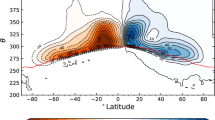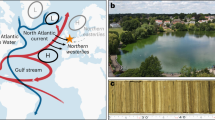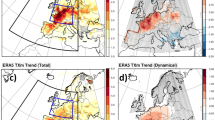Abstract
A crucial question in the global-warming debate concerns the extent to which recent climate change is caused by anthropogenic forcing or is a manifestation of natural climate variability1. It is commonly thought that the climate response to anthropogenic forcing should be distinct from the patterns of natural climate variability. But, on the basis of studies of nonlinear chaotic models with preferred states or ‘regimes’, it has been argued2,3 that the spatial patterns of the response to anthropogenic forcing may in fact project principally onto modes of natural climate variability. Here we use atmospheric circulation data from the Northern Hemisphere to show that recent climate change can be interpreted in terms of changes in the frequency of occurrence of natural atmospheric circulation regimes. We conclude that recent Northern Hemisphere warming may be more directly related to the thermal structure of these circulation regimes than to any anthropogenic forcing pattern itself. Conversely, the fact that observed climate change projects onto natural patterns cannot be used as evidence of no anthropogenic effect on climate. These results may help explain possible differences between trends in surface temperature and satellite-based temperature in the free atmosphere4,5,6.
This is a preview of subscription content, access via your institution
Access options
Subscribe to this journal
Receive 51 print issues and online access
$199.00 per year
only $3.90 per issue
Buy this article
- Purchase on Springer Link
- Instant access to full article PDF
Prices may be subject to local taxes which are calculated during checkout




Similar content being viewed by others
References
Houghton, J. T.et al. (eds) Climate Change 1995: The Science of Climate Change (Cambridge Univ. Press, (1996).
Palmer, T. N. Anonlinear dynamical perspective on climate change. Weather 48, 313–348 (1993).
Palmer, T. N. Anonlinear dynamical perspective on climate prediction. J. Clim. 12, 575–591 (1999).
Christy, J. R. & McNider, R. T. Satellite greenhouse signal. Nature 367, 325 (1994).
Hurrell, J. W. & Trenberth, K. E. Difficulties in obtaining reliable temperature trends: reconciling the surface and satellite microwave sounding units records. J. Clim. 11, 945–967 (1998).
Wentz, F. J. & Schabel, M. Effects of orbital decay on satellite-derived lower-tropospheric temperature trends. Nature 394, 661–664 (1998).
Abarbanel, H. D. I., Brown, R. & Kennel, M. B. Variation of Lyapunov exponents on a strange attractor. J. Nonlin. Sci. 1, 175–199 (1991).
Lorenz, E. N. Deterministic nonperiodic flow. J. Atmos. Sci. 20, 130–141 (1963).
Kimoto, M. & Ghil, M. Multiple flow regimes in the northern hemisphere winter. Part I: Methodology and hemispheric regimes. J. Atmos. Sci. 50, 2625–2643 (1993).
Silverman, B. W. Density Estimation for Statistics and Data Analysis (Chapman & Hall, New York, (1986).
Molteni, F., Tibaldi, S. & Palmer, T. N. Regimes in the wintertime circulation over northern extratropics. I: Observational evidence. Q. J. R. Meteorol. Soc. 116, 31–67 (1990).
Cheng, X. & Wallace, J. M. Cluster analysis of the Northern Hemisphere wintertime 500-hPa height field: spatial patterns. J. Atmos. Sci. 50, 2674–2696 (1993).
Wallace, J. M., Zhang, Y. & Bajuk, L. Interpretation of interdecadal trends in Northern Hemisphere surface air temperature. J. Clim. 9, 249–259 (1996).
Wallace, J. M. & Gutzler, D. S. Teleconnections in the geopotential height field during the northern hemisphere winter. Mon. Weath. Rev. 109, 784–812 (1981).
Palmer, T. N. Medium and extended range predictability, and stability of the PNA mode. Q. J. R. Meteorol. Soc. 114, 691–713 (1988).
Hurrell, J. W. Decadal trends in the North Atlantic Oscillation: regional temperature and precipitation. Science 269, 676–679 (1995).
Thompson, D. W. J. & Wallace, J. M. The Arctic Oscillation signature in the wintertime geopotential height and temperature fields. Geophys. Res. Lett. 25, 1297–1300 (1998).
Renwick, J. A. & Wallace, J. M. Relationships between North Pacific blocking, El Nino and the PNA pattern. Mon. Weath. Rev. 124, 2071–2076 (1996).
Molteni, F., Ferranti, L., Palmer, T. N. & Viterbo, P. Adynamical interpretation of the global response to equatorial Pacific SST anomalies. J. Clim. 6, 777–795 (1993).
Marshall, J. & Molteni, F. Towards a dynamical understanding of planetary-flow regimes. J. Atmos. Sci. 50, 1792–1818 (1993).
Farrell, B. F. & Ioannou, P. J. Generalised stability theory: Part II: Nonautonomous systems. J. Atmos. Sci. 53, 2042–2053 (1996).
Corti, S. & Palmer, T. N. Sensitivity analysis of atmospheric low-frequency variability. Q. J. R. Meteorol. Soc. 123, 2425–2447 (1997).
Bengtsson, L. & Shukla, J. Integration of space and in situ observations to study global climate change. Bull. Am. Meteorol. Soc. 69, 1130–1143 (1988).
Hannachi, A. Low-frequency variability in a GCM: Three-dimensional flow regimes and their dynamics. J. Clim. 10, 1357–1379 (1997).
Shindell, D. T., Miller, R. L., Schmidt, G. A. & Pandolfo, L. Simulation of recent northern winter climate trends by greenhouse-gas forcing. Nature(in the press).
Acknowledgements
S.C. and F.M. were supported by the Commission of the European Communities under project MILLENNIA (Numerical Simulation and Analysis of Climate Variability on Decadal and Centennial Time Scales).
Author information
Authors and Affiliations
Corresponding author
Rights and permissions
About this article
Cite this article
Corti, S., Molteni, F. & Palmer, T. Signature of recent climate change in frequencies of natural atmospheric circulation regimes. Nature 398, 799–802 (1999). https://doi.org/10.1038/19745
Received:
Accepted:
Issue Date:
DOI: https://doi.org/10.1038/19745
This article is cited by
-
Asthma incidence can be influenced by climate change in Italy: findings from the GEIRD study—a climatological and epidemiological assessment
Scientific Reports (2023)
-
Stochastic and statistical stability of the classical Lorenz flow under perturbations modeling anthropogenic type forcing
Bollettino dell'Unione Matematica Italiana (2023)
-
Seasonal and regional contrasts of future trends in interannual arctic climate variability
Climate Dynamics (2023)
-
Changes in temperature–precipitation correlations over Europe: are climate models reliable?
Climate Dynamics (2023)
-
Impacts of dynamical downscaling on circulation type statistics in the Euro-CORDEX ensemble
Climate Dynamics (2022)
Comments
By submitting a comment you agree to abide by our Terms and Community Guidelines. If you find something abusive or that does not comply with our terms or guidelines please flag it as inappropriate.



